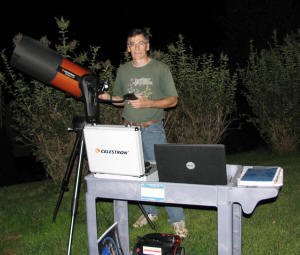 Here I am in my back yard in Erie, Pennsylvania,
"playing" with my newly acquired (in June) Celestron NexStar 8SE telescope. City lights are fairly bright
here to the east and west, but farm land is to the south and Lake Erie begins two
miles to the north, so that limits the light pollution somewhat. Erie is not that
large of a city, so that also helps. Still, compared to the truly dark skies in
areas I have lived in Vermont and Colorado, the seeing is noticeably bad. I haven't
had a chance to try any of the filters that came with the eyepiece and filter kit
that came with the scope.
I also bought a Celestron NexImage
camera for use with the telescope. It is only good for really bright objects like
planets and the moon, mainly because the stock interface does not allow long time
exposures. However, there is a hack online that modifies it for longer settings.
The pixel resolution is only 640 x 480, so it's probably not worth the trouble.
I've seen some pretty impressive photos of the moon and Saturn that were taken with
it. Deep sky photos will probably have to wait until I have $800 or so to throw
at a DSLR camera.
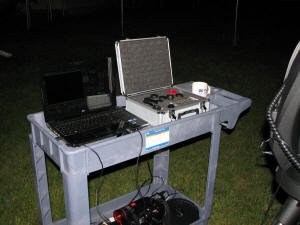 The equipment cart is really handy for transporting
the DC power supply for the telescope, the Celestron eyepiece and filter kit, dew cover, notebook computer,
etc. It also places everything at a convenient height for working. One advantage
(if you can call it that) of having so much ambient light to deal with it that the
extra light from the computer display is not too annoying, plus, it provides enough
light to view star charts. For times when I don't bring the computer out, I have
found that the light from the GoTo hand controller is just bright enough to allow
the charts to be read. The equipment cart is really handy for transporting
the DC power supply for the telescope, the Celestron eyepiece and filter kit, dew cover, notebook computer,
etc. It also places everything at a convenient height for working. One advantage
(if you can call it that) of having so much ambient light to deal with it that the
extra light from the computer display is not too annoying, plus, it provides enough
light to view star charts. For times when I don't bring the computer out, I have
found that the light from the GoTo hand controller is just bright enough to allow
the charts to be read.
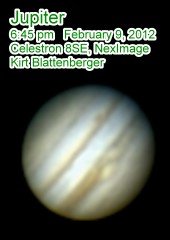 To the left is more recent image (2/9/2012) of Jupiter. I'm getting
a little better. The sky was exceptionally clear, winds nonexistent, and the nearly
full moon had not risen above the eastern horizon yet. Jupiter was about 15° west
of due south, high in the sky. My Celestron NexImage was used with a 2x Barlow lens.
The photo is a composite of about 500 short time exposure images recorded at 5 fps.
This really helped avoid atmospheric scintillation. If I had done a better job on
the focus, the detail might have been even better. RegiStax v2 software was used. To the left is more recent image (2/9/2012) of Jupiter. I'm getting
a little better. The sky was exceptionally clear, winds nonexistent, and the nearly
full moon had not risen above the eastern horizon yet. Jupiter was about 15° west
of due south, high in the sky. My Celestron NexImage was used with a 2x Barlow lens.
The photo is a composite of about 500 short time exposure images recorded at 5 fps.
This really helped avoid atmospheric scintillation. If I had done a better job on
the focus, the detail might have been even better. RegiStax v2 software was used.
 To the right is my first ever image of Venus. To the right is my first ever image of Venus.
Below is my first picture of Jupiter, taken on the evening of September 24, 2011,
in Erie, Penn. Sure, there are millions of nicer examples out there, but they aren't
mine.
The seeing conditions were not great, with a slight haze and very heavy dew.
The dew shield helped, but when the telescope is facing skyward by more than about
45-50 degrees, the dew manages to condense on the glass anyway. This image was generated
by RegiStax using the best 156 frames out of a 301 frame shot. By November, Jupiter
will be nice and high in the sky in the evening, so there won't be as much unstable
atmosphere to look through.
Here is a handy
moon age calculator.
Here is an equally handy
Great Red Spot transit calculator.
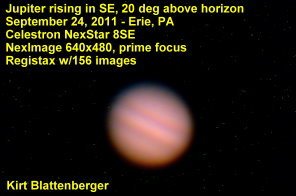 I'll soon post a photo of the truly nice custom
fabric dust cover that Melanie made for me that conforms perfectly to the telescope
and even to the 9x60 mm Orion finder scope that I installed in place of the stock
el-cheapo (but very functional) finder. I'll soon post a photo of the truly nice custom
fabric dust cover that Melanie made for me that conforms perfectly to the telescope
and even to the 9x60 mm Orion finder scope that I installed in place of the stock
el-cheapo (but very functional) finder.
If you're interested, here is my original amateur astronomy page on Airplanes and Rockets. Also, here is
a page I posted on my RF Cafe website with a few
astrophotos
taken using a Canon S1 2S Power Shot, mounted on a tripod. That type of camera cannot
be used with a standard telescope adapter because the lens is not removable.
On October 7, 2011, I managed to capture Jupiter's Great Red Spot using the Celestron
NexImage camera. It's not very good, but I did confirm, using the Transit Time calculator
on the
Sky & Telescope website, that there was a transit at 9:46 pm EDT on that
night, so it's definitely the Great Red Spot. All four Galilean moons were also
clearly visible that night, too.
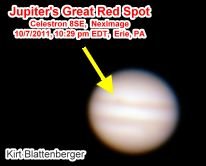 October 7, 2011 Update: October 7, 2011 Update:
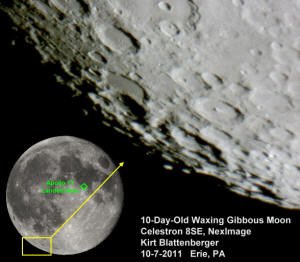
Posted May 8, 2023
(updated from original post
on 9/24/2011)
|